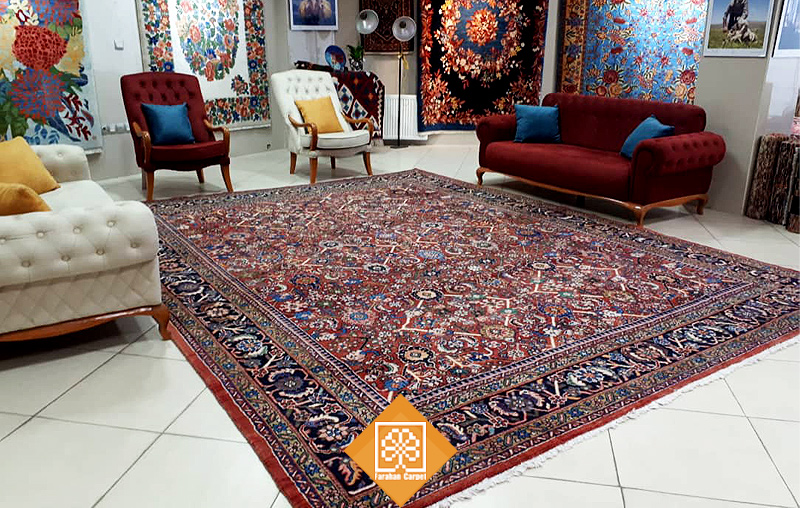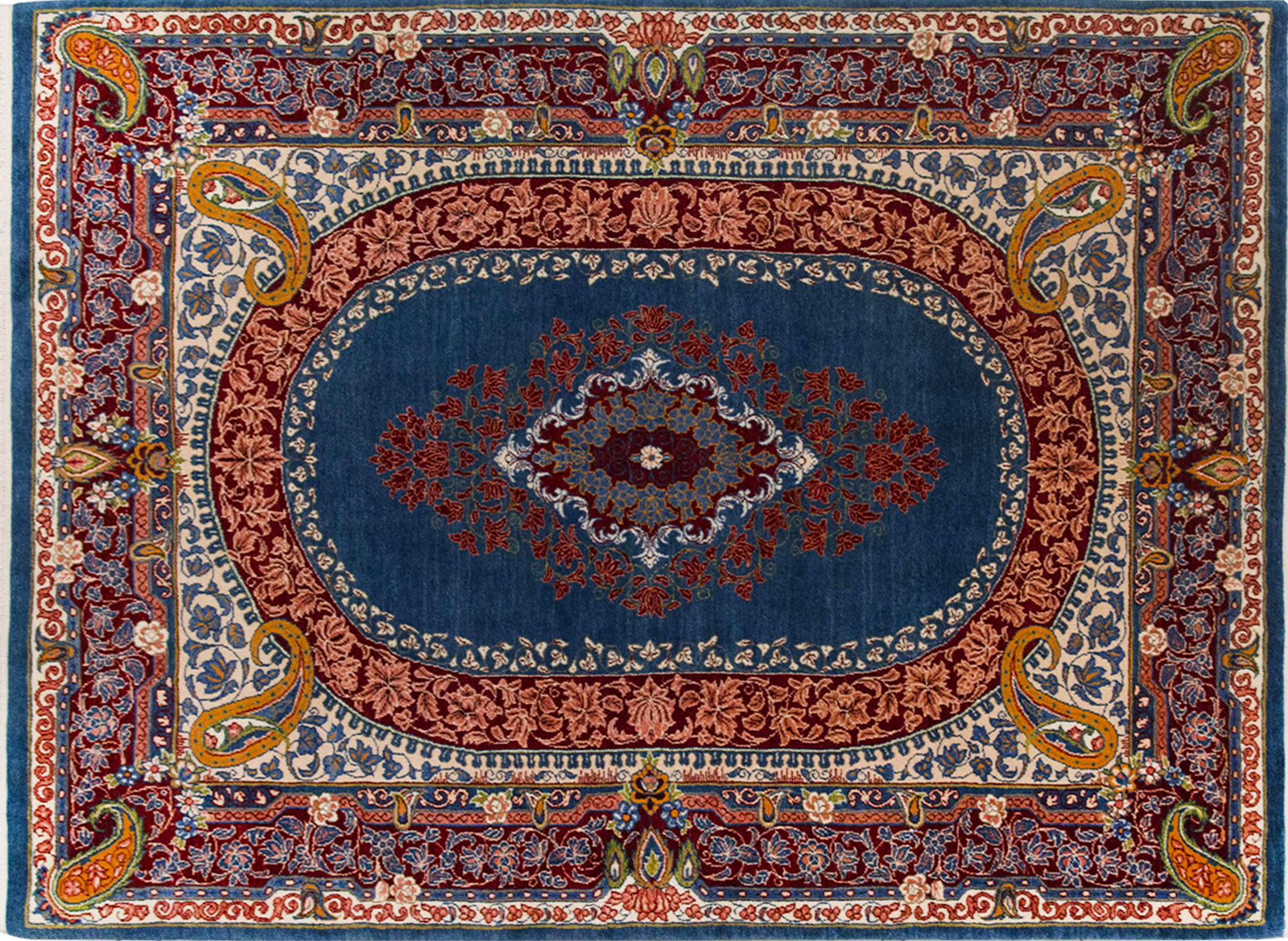Sultanabad carpet (rug) | Full review of features

Sultanabad handmade carpet with a history of several hundred years is one of the original examples of Iranian carpets. Sultanabad is the old name of Arak city, which has been known not only in Iran but also in the world and international exports by benefiting from the production of carpets in the surrounding cities, including Sarouk and Farahan.
Iranian carpets in every region and area of our country have their own characteristics and beauties that have made people with different tastes can make their choice, this is the case with Sultanabad handmade carpets quality and simplicity. Be.
In Farahan Carpet Collection, this time we want to examine the exact characteristics of Arak carpets from zero to one hundred for you so that if you are looking to buy them, you can make a correct and correct choice.
History of Sultanabad carpets
The exact date of origin and date of Sultanabad handmade carpet is not available, but according to two narrations, this date is between 300 to 700 years, in any case, each of the above dates should definitely indicate the high originality of the carpet texture It is in Arak and Markazi province.
Before Sultanabad became a city (Arak), weaving was done in different areas around it, all of which were considered more like Arak. Among these areas, Farahan and Sarough can be considered the flagship. Over time, they became even more famous than Arak carpets.
In history, when Shapur Zolakataf passed through Farahan, he was given a gift that shows the high antiquity of carpet weaving in Markazi province, which from the middle of the reign of Naser al-Din Shah almost began its colorful presence and world fame.
At the beginning of the history of Sultanabad handmade carpets, if we take a look, we will see that the weaving was done completely locally and for personal use, which soon due to the excellent geographical location of Arak on trade routes, Sultanabad became the center of carpet trade. Iran became.
In fact, Arak can be introduced as a turning point in the development of Iranian hand-woven carpets, which made this unique art of Iranians known throughout the world.
Global design of Sultanabad handmade carpets
As we mentioned in the previous section, Sultanabad handmade carpets were very popular with merchants in European and American countries due to their geographical location, and it did not take long for large companies such as Ziegler to decide to invest in Arak to produce hand-woven carpets.
In 1260 and the word of this Swiss company to Arak European and British designers trying to design models close to the culture and taste of the people of their countries to increase exports, this issue had caused all eyes in Iran to Sultanabad ( Arak) to be drawn.
For this reason, domestic companies, such as Qali Shargh, were the first city after Kerman to establish a representative office in Arak, and these events over time improved the quality of woven products in this province.
Another issue that came up with the presence of foreign designers for Sultanabad handmade carpets was moving with the needs of the international community and producing modern handmade carpets. Introduced carpet production and export in the basin.
The main features of Arak carpet
When we look at the history, name, and reputation of Sultanabad handmade carpets, these successes have definitely not been without reason. There have been features in the carpets of this province that have made it so popular, which are summarized below for We will introduce you.
As we said, the main issue is the simple and quality products of carpets in this province.
Variety of very high and diverse designs, including bergamot, Afshan, Shah Abbasi, forest, hunting ground, tree and screw, brick, Sheikh Safi, Islamic, henna, fish, single bush, huge map, bush mir, goat horn, Mostofi, And small flowers and lilies and basil.
Convenient and convenient adaptation to modern and European decorations, which has made it very popular for export.
Sultanabad handmade carpet is a coarse-textured type that using a high number of ridges (between 15 to 25) has created a special and special model in terms of composition.
The use of regional indigenous nature and available fibers, plant dyeing, and simple designs are among the most important features of Arak carpets. According to the original culture of carpet weaving in Markazi province, a very rare issue is the lack of weaving and counterfeit knots and pairs in its carpets.
Although fine-woven and custom models can be seen in Arak carpets, most of the work done is coarse-textured and heavy, so their price is basically considered cheap handmade carpets.
The main and predominant colors used in Arak carpets due to the presence of 3 special colors make it different from other hand-woven carpets: Sarough Doogh, Abi Farahan, and Ronasi Meshkabad.
Investigation of Sultanabad handmade carpet texture
In Arak, the method used for weaving their carpets is Persian weaving, which is used more for knitting knots by hand, unlike the Turkish weaving method, which is done with hooks.
In addition to the 3 dominant colors that we mentioned in the previous section, Sultanabad handmade carpet is made of Farahan doogh red, blue, yellow, lacquered camel, crimson, green, light green, cream, beige, copper, fawn, brown, blue flower, car, Gold and olives are also used, which in the past were made from rhubarb, pomegranate skin, hair leaves, walnut skin, etc.
The texture of hand-woven carpets in Arak is mostly using vertical beads, which are coarsely woven.
An important negative point that was stated about the texture of Sultanabad carpet is the use of specific and repetitive designs that create a certain uniformity in the products and gradually lose their popularity, which we have tried in Farahan carpet with Making this change, we can take back the real value and status of handmade carpets in Markazi province.
Read more: Bakhtiari handmade carpets | Comprehensive review of various models and designs
Introducing carpets in other areas of Markazi province
After examining the handmade carpets of Sultanabad or today’s Arak, we want to take a general look at the carpets of other villages and cities of Markazi province, which in some cases are even known as Arak carpets:
Farahan carpet: A quality carpet that is woven with high-quality wool and the height of the piles is basically very short, but you should note that these explanations are about the classic and old Farahan carpet that we should not forget is world-famous.
Sarough carpet: Sarough carpet is also one of the main examples of carpets in Markazi province, which has a worldwide reputation that expresses different shapes and colors, and the texture is very good and dense with very soft wool. In most designs and designs of Sarooq carpets, “joy of life” waves.
Mohajeran Carpet: Another city that has been able to find a very good position in the field of hand-woven carpets is Mohajeran City, which is located in the neighborhood of Sultanabad and produces its carpets under the name of American Sarooq with long pile and bouquet design.
Lilian Carpet: A village that is located near the city of Arak, but many experts consider woven carpets in this village to be very similar to carpets in the Hamedan region, but most of its products are sold in Aram Bazaar under the name of Sultanabad handmade carpets.
Meshk Abad Carpet: An area close to Arak where, like Lilian, many of its products and weaves are sold under the name of Sultan Abad Handmade Carpet, but if we pay attention to its background, we will see antique samples that have a very special and unique quality.




